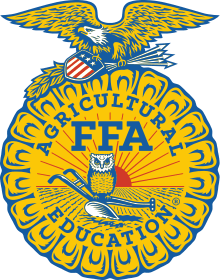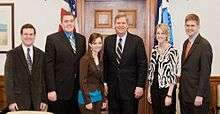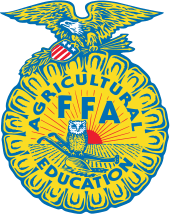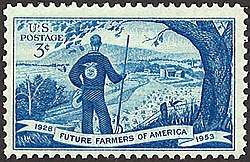National FFA Organization
National FFA Organization is an American 501(c)(3) youth organization, specifically a career and technical student organization, based on middle and high school classes that promote and support agricultural education. It was founded in 1925 at Virginia Polytechnic Institute, by agriculture teachers Henry C. Groseclose,[9] Walter Newman, Edmund Magill, and Harry Sanders as Future Farmers of Virginia. In 1928, it became a nationwide organization known as Future Farmers of America. In 1988 the name was changed to the National FFA Organization, now commonly referred to as FFA, to recognize that the organization is for students with diverse interests in the food, fiber, and natural resource industries, encompassing science, business, and technology in addition to production agriculture.[10] Today FFA is among the largest youth organizations in the United States, with 669,989 members in 8,630 chapters[11] throughout all 50 states, Puerto Rico, and the Virgin Islands. FFA is the largest of the career and technical student organizations in U.S. schools.
 | |
| Motto | Learning to Do, Doing to Learn, Earning to Live, Living to Serve[1] |
|---|---|
| Formation | 1928 |
| Type | Youth organization |
| 54-0524844[2] | |
| Legal status | 501(c)(3) non-profit organization[3] |
| Purpose | To make a positive difference in the lives of students by developing their potential for premier leadership, personal growth, and career success through agricultural education. |
| Headquarters |
|
Region served | |
Membership | 669,989 (8,630 Chapters in 52 State Associations) |
| Dr. James Woodard[4] | |
Chief Executive Officer | Mark Poeschl[5] |
Chief Operating Officer | [6] |
National FFA President | Kolesen McCoy[7] |
| Subsidiaries | National FFA Foundation, Inc.[2] |
Revenue (2015) | $27,832,251[2] |
| Expenses (2015) | $27,612,465[2] |
Employees (2015) | 232[2] |
Volunteers (2015) | 3,500[2] |
| Website | www |
Formerly called | Future Farmers of America[8] |
The organization holds a congressional charter under Title 36 of the United States Code.[12]
Overview
The National FFA Organization is a youth leadership organization that makes a positive difference in the lives of young people by developing their potential for premier leadership, personal growth, and career success through agriculture education. The FFA Motto is Learning to Do, Doing to Learn, Earning to Live, Living to Serve.
FFA functions within the three-circle model of agricultural education as a student leadership organization that complements a student's classroom/laboratory instruction and supervised agricultural experience program.[13] FFA members can compete in Career Development Events (CDE) that cover job skills in everything from communications to mechanics. Some events allow students to compete as individuals, while others allow them to compete in teams.[14] These competitions can happen at a local or district level, state level, and on the national level.
Students are supervised by agricultural education teachers in cooperation with parents, employers, and other adults who assist individuals in the development and achievement of educational and career goals
The official colors of FFA are National Blue and Corn Gold.[15]
FFA structure

FFA is represented at several different levels across the nation; FFA administration may change from state to state. The basic levels are the national level, serving all of the United States of America, Puerto Rico and the U.S. Virgin Islands; the state level, serving an individual state association; and the chapter level, serving a school or set of schools in an area. By definition, there can be three types of chapters at the secondary level, they are middle for middle school, junior for ninth grade and senior which can be either tenth through twelfth or ninth through twelfth depending on the school. Other levels include districts, sub districts, sections, regions, areas, and federations.
FFA was created to serve high school students and has moved into middle schools where membership may begin as early as age 12, allowing members to become active earlier and stay active longer. Each chapter is chartered as part of the state association and national organization. Collegiate chapters exist as well.
Most states hold FFA conventions at least once annually, where members gather to compete, be recognized for awards, attend leadership workshops, debate organizational issues in a delegate process, and more. Nationally, the National FFA Convention & Expo is held once a year in the fall. It was held in Kansas City, Missouri, from 1928 to 1998. The convention moved to Louisville, Kentucky, in 1999 before moving again in 2006 to Indianapolis, Indiana. Louisville again hosted the national convention from 2013 to 2015. FFA announced in July 2015 that the national convention would be hosted in Indianapolis each year from 2016 to 2024.[16]
Officers of FFA
As FFA is a student-led organization intended to serve youth around the nation, it elects officers from its own diverse membership to certain levels of FFA. With these basic constitutional officers a basis of parliamentary procedure is completed during meetings and banquets; each officer during these procedures will stand and recite their office level and what it is stationed by, and why the particular position is stationed as so. Typical officer roles are:
Constitutional officers
- President — Stationed by the rising sun, a token of a new era in agriculture; presides over meetings
- Vice President — Stationed by the plow, the symbol of labor and tillage of the soil; presides over meetings in the absence of the president
- Secretary — Stationed by the ear of corn, to keep a record of all meetings and correspond with other secretaries wherever corn is grown and FFA members meet
- Treasurer — Stationed by the emblem of George Washington, to keep an accurate account of receipts and disbursements just as Washington kept his farm accounts, carefully and accurately
- Reporter — Stationed by the Flag, strives to inform the public in order that every man, woman, and child may know that FFA is a national organization that reaches from the state of Alaska to the Virgin Islands and from the state of Maine to Hawaii
- Sentinel — Stationed by the door, to ensure the door is open to all, care for the meeting room and paraphernalia, strives to keep the meeting room comfortable as well as assists the president in maintaining order
- Advisor — Stationed by the owl, the time honored emblem of knowledge and wisdom
Others may include
- Parliamentarian — Stationed by a copy of Robert's Rules of Order
- Historian — Stationed at the scroll or chapter scrapbook
- Student Advisor — Stationed by the owl or the key
- Executive Committee/Executive Board
Each officer is an agriculture student and holds responsibilities needed to serve. Officers are elected each year by members at the respective level.
National officers
At the national level, the organization has student-held positions of president, secretary, and vice president for each of the four administrative regions (Eastern, Southern, Central, and Western).
Official FFA dress
.jpg)

FFA jacket
The most recognizable symbol of the organization is the blue corduroy jacket that is worn by FFA members. The back of the jacket features a large FFA emblem underneath the name of the member's state. The name of the local FFA chapter, district, region, or area is embroidered below the emblem. The front of the FFA jacket features a smaller FFA emblem on the left chest and the FFA member's name and sometimes, if applicable, office and year on the right chest. FFA members are required to wear the jacket as part of official dress while participating in all official organization activities.[17]
The FFA jacket was created to be worn by the Fredericktown Band of the Fredericktown FFA Chapter by Dr. Gus Lintner.[18] It was adopted in 1933.
The color of the jacket's corduroy has ranged from shades of blue to shades of purple through the years. In 2004, the National FFA Organization worked with a supplier in North Carolina to set a new standard for the blue corduroy by using samples from archived FFA jackets. The jacket's color standardization was accompanied by a restoration of the embroidered FFA emblems and fit corrections led by Clemson University's Apparel Research Center. The improved FFA jacket, produced in both Van Wert, Ohio and South Vietnam, was first made available in August 2005. Currently, all lettering, embroidery and finishing of FFA jackets is completed by Universal Lettering Company in Van Wert, Ohio.[19]
Elements of FFA official dress
FFA members are required to wear official FFA dress while participating in official organization activities. The National FFA Organization recently updated its bylaws, stating that members may choose to identify however they choose in regards to official dress, in order to include transgender as well as gender non-conforming individuals within the organization. For females, official dress consists of a black skirt (black slacks may be appropriate for travelling and outdoor activities), a white collared blouse, an official FFA blue scarf, black dress shoes with closed heel and toe, black nylon hosiery, and an official FFA jacket zipped to the top. Male official dress includes black dress pants, a white dress shirt, an official FFA tie, black dress shoes with closed heel and toe, black socks, and an official FFA jacket zipped to the top.[17]
Awards and pins
FFA members earn metal pins that signify achievement within the organization. These pins can be placed on the front of the FFA jacket,[17] however, official guidelines state that no more than three pins may be worn at one time. The pins are to be placed beneath the FFA member's name on the right chest and can recognize highest degree, highest office, and/or highest award in that order from left to right. Two exceptions exist within pin placement guidelines. When an FFA member earns a State FFA Degree or American FFA Degree, the award keys should be worn above the name on right chest or attached to the FFA jacket with a standard key chain, and no other pins should accompany these.[17]
Traditions

FFA has many traditions and trademarks identifying it as an agricultural education organization:[20]
The FFA Motto: Learning to Do, Doing to Learn, Earning to Live, Living to Serve.
The FFA Mission: The National FFA Organization is dedicated to making a positive difference in the lives of students by developing their potential for premier leadership, personal growth, and career success through agricultural education.[20]
The Official FFA Colors: National Blue and Corn Gold (worn on the Official FFA jackets).[21]
The FFA Emblem: Cross section of the ear of corn: represents unity. Wherever you live in the United States, corn is grown everywhere. Rising Sun: signifies progress. It represents that tomorrow will always bring a new day. Plow: signifies labor and tillage of the soil. It also shows the historic foundation of our country's strength. Eagle: symbolizes freedom and our ability to explore the new agriculture world. Owl: represents knowledge. Long recognized for wisdom and knowledge. Agriculture Education and FFA: symbolizes the combination of learning and leadership.
The FFA Creed: The creed was written by Erwin Milton "E.M." Tiffany of Lyndon, Kansas[22] and adopted at the 3rd National FFA Convention.[22] It was revised at the 38th and 63rd National FFA Conventions by the assembled delegate body. It is recited by new members to the organization to reflect their growing belief in agriculture and agricultural education. The FFA Creed also must be memorized and recited to earn the Greenhand Degree.
I believe in the future of agriculture, with a faith born not of words but of deeds – achievements won by the present and past generations of agriculturists; in the promise of better days through better ways, even as the better things we now enjoy have come to us from the struggles of former years.
I believe that to live and work on a good farm or to be engaged in other agricultural pursuits, is pleasant as well as challenging; for I know the joys and discomforts of agricultural life and hold an inborn fondness for those associations which, even in hours of discouragement I cannot deny.
I believe in leadership from ourselves and respect from others. I believe in my own ability to work efficiently and think clearly, with such knowledge and skill as I can secure, and in the ability of progressive agriculturists to serve our own and the public interest in producing and marketing the product of our toil.
I believe in less dependence on begging and more power in bargaining; in the life abundant and enough honest wealth to help make it so-for others as well as myself; in less need for charity and more of it when needed; in being happy myself and playing square with those whose happiness depends upon me.
I believe that American agriculture can and will hold true to the best traditions of our national life and that I can exert an influence in my home and community which will stand solid for my part in that inspiring task.
Career Development Events
FFA Career Development Events (CDEs) are contests that members compete in to test their skills learned through agricultural education instruction. They vary at the different levels of FFA, and some are contested only at certain levels and certain states, districts, areas, or federations.[23]
At the national level, there are 24 Career Development Events:[23]
- Ag Business
- Ag Communications
- Ag Issues Forum
- Ag Mechanics
- Ag Sales
- Agronomy (Insects, seeds, etc.)
- Dairy cattle evaluation
- Dairy Cattle Handlers Activity
- Dairy Foods
- Environmental & Natural Resources
- Extemporaneous Public Speaking
- Floriculture
- Food Science & Technology
- Forestry
- Horse Evaluation
- Job Interview
- Homesite Evaluation
- Land Judging
- Livestock Evaluation
- Marketing Plan
- Meats Evaluation & Technology
- Nursery/Landscape
- Parliamentary Procedure
- Poultry Evaluation
- Prepared Public Speaking
- Rangeland Judging
- Wildlife Management
- Veterinarian Science
- Quiz Bowl
Others
Examples of CDEs that can be available at the state level are:
- Small Animal Care
- Arboriculture
- Aquaculture
- Safe Equipment Operation
- Opening/Closing Ceremonies
- Wildlife
- Website Development
- Entomology
- Tractor Operations
- Greenhand CDE
- F.A.R.M education
- Envirothon
- Demonstration
Supervised Agricultural Experience Programs
To be an active member in the National FFA Organization, a member must have a Supervised Agricultural Experience (SAE) project.[24] The projects involve hands-on application of concepts and principles learned in the agricultural education classroom, with guidelines for the SAE projects governed by the state FFA delegation. SAE programs are grouped into four different areas:
- Exploratory – learning about the 'big picture' of agriculture and related careers
- Research/Experimentation and Analysis – conducting research or analysis of information to discover new knowledge
- Ownership/Entrepreneurship – planning and operation of an agriculture-related business
- Placement – working either for pay or experience in an agricultural setting
Notable alumni
In politics
- Harold Brubaker, North Carolina state representative, past National FFA Secretary from Pennsylvania
- Jimmy Carter, Governor of Georgia, 39th President of the United States
- Matt Lohr, Chief of USDA’s Natural Resources Conservation Service, former Virginia state representative, past state FFA President and National FFA Vice President
- Bruce Maloch, Arkansas state senator, past state FFA President and National FFA Secretary
- Rick Perry, former United States Secretary of Energy, former Governor of Texas, past district FFA officer
- Jeff Miller (Florida politician), United States Representative from Florida, past state FFA Secretary
- Jason Smith (politician), United States Representative from Missouri
- Sam Brownback, United States Ambassador at Large for International Religious Freedom, former Governor of Kansas, former United States Senator, former United States representative, past state FFA President and national FFA vice president
- Joe Wright, Kentucky State Senate majority floor leader from 1981 to 1992 and founding member of the Kentucky FFA Foundation
In entertainment
- Trace Adkins, country music singer
- Johnny Cash, country and rock & roll music singer/songwriter, actor
- Chris Colfer, actor best known for Glee
- Easton Corbin, country music singer/songwriter
- Steve Doocy, network-television personality on the Fox News Channel and a best selling author. Co-host of Fox & Friends in the mornings.
- Matthew Fox, actor best known for Lost and Party of Five
- Brantley Gilbert, country music singer
- Don Henley, music entertainer
- Toby Keith, country music singer, actor
- Lyle Lovett, country music singer
- Taj Mahal (musician), singer, songwriter, legally Henry Saint Clair Fredericks. Was dairy farmer in Massachusetts
- Tim McGraw, country music singer
- Eddie Montgomery, country music singer, half of the duo Montgomery Gentry
- Willie Nelson, country music singer
- Jim Ross, WWE Hall of Famer, past state FFA Vice President
- Orion Samuelson, radio broadcaster
- Josh Shipp, motivational speaker & entertainer
- Taylor Swift, country and pop music singer/songwriter, actress
- Craig Morgan, country music singer/songwriter
- A$AP Rocky, rapper, songwriter, record producer, actor
- John Mellencamp, recording artist, co-founder of Farm Aid
In the arts
- Jim Davis, creator of the Garfield comic strip
- Jared Hess, director of Napoleon Dynamite
- Nicholas Kristof, Pulitzer Prize Winner, past Oregon State Officer
Other
- Leonard J. Arrington, Church of Jesus Christ of Latter Day Saints Historian. "Dean of Mormon History", past National FFA Vice President
- Howard Warren Buffett, grandson of famed American investor and philanthropist Warren Edward Buffett, past FFA chapter president
- Bo Jackson, American athlete and a former multi-sport professional in American football (NFL) and Baseball (MLB)
- Sterling Marlin, NASCAR driver
- Brad Meester, American football center for the Jacksonville Jaguars of the National Football League, past FFA chapter president
- Rebecca Podio, Miss Wyoming 2013
- Bryant Reeves, retired American professional basketball player for the NBA's Vancouver Grizzlies
- Carroll Shelby, American automotive designer, racing driver and entrepreneur
- Chris Soules, The Bachelorette contestant and The Bachelor star, past Iowa FFA Member
- Harry Stine, founder and owner of Stine Seed, past Iowa FFA Member
- Mark Tauscher, American football Offensive Tackle for the Green Bay Packers of the National Football League
Notable historic events and milestones

- 1928: FFA is established.
- 1929: National Blue and Corn Gold are adopted as official colors.
- 1930: Official FFA creed adopted.
- 1944: FFA Foundation formed.
- 1950: Congress grants FFA a Federal Charter, recognizing the importance of FFA as an integral component of School-Based Agricultural Education.
- 1953: FFA U.S. postage stamp issued by U.S. Postal Service.
- 1965: FFA was desegregated; FFA absorbed the New Farmers of America organization for students of color.
- 1969: FFA membership becomes available to female students.
- 1988: Official Name change from Future Farmers of America to National FFA Organization.
- 2006: National FFA Foundation receives first $1 million contribution from Ford Motor Company.
- 2010: FFA members earn a record 3,449 American FFA Degrees.
- 2011: National FFA Alumni Association celebrates its 40-year anniversary.
- 2015: National FFA celebrates 50 years of desegregation following the merger of FFA and NFA.
- 2017: National FFA elects first female African-American National President, Ms. Breanna Holbert from the State of California.
- 2019: FFA celebrates 50 years of female leaders in the organization.
References
- "FFA Mission and Motto". National FFA Organization.
- "Form 990: Return of Organization Exempt from Income Tax". Future Farmers of America. Guidestar. December 31, 2015.
- "Future Farmers of America State Associations & Local Chapter". Exempt Organizations Select Check. Internal Revenue Service. Retrieved 1 May 2017.
- "Our Leadership". National FFA Organization. Retrieved 17 October 2014.
- "National FFA Organization and National FFA Foundation Name Mark Poeschl Chief Executive Officer". National FFA Organization. Retrieved 29 July 2016.
- "Our Leadership". National FFA Organization. Retrieved 1 May 2017.
- "2019-2020 election". National FFA Organization. Retrieved 21 November 2019.
- "Who We Are". National FFA Organization. Retrieved 17 October 2014.
- "Future Farmers to Meet Aug. 6-9: 1,000 Young Virginians Will Compete for Honors at Blacksburg". The Washington Post. 3 August 1929. p. 18.
- "FFA History". National FFA Organization. p. 2.
- "Statistics". National FFA Organization.
- "36 USC § 70901 – Organization". Federal Charter; Future Farmers of America is a federally chartered corporation. Legal Information Institute; Cornell Law School.
- "School-Based Agricultural Education" (PDF). National FFA Organization.
- "Career Development Events". National FFA Organization.
- "National FFA Organization - Home". www.ffa.org. Retrieved 28 March 2018.
- "National FFA Organization Announces National Convention and Expo Coming to Indianapolis 2016-2024". National FFA Organization. Retrieved 29 July 2016.
- "FFA Official Dress". National FFA Organization.
- Langstaff, Dave. "A Brief History of The FFA Jacket and The People Who Make It". Universal Lettering Company. Retrieved 2010-06-05.
- "FFA Official Dress PDF" (PDF). National FFA Organization.
- 105th U.S. Congress (August 12, 1998). "Public Law 105-225" (PDF). National FFA Organization. p. 6.
- "FFA Facts". Code of Ethics, Creed, Emblem, Mission, Motto, Name, Official Colors, Official Dress, Salute. Minnesota FFA Association. Retrieved 2010-06-05.
- "The FFA Creed". National FFA Organization. Retrieved 2010-06-05. It was written in 1928
- "FFA Career Development Events (CDE)". National FFA Organization. Retrieved 2013-03-11.
- "FFA Supervised Agricultural Experience (SAE)". National FFA Organization. Retrieved 2013-03-11.
External links
| Wikimedia Commons has media related to National FFA Organization. |